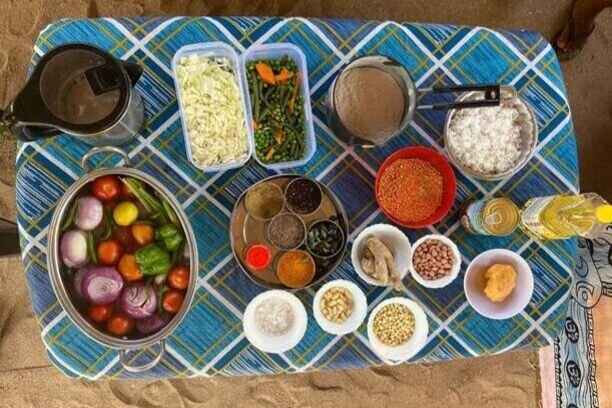Yoga isn’t just about stretching your body — it’s about nourishing every part of you. And one of the key ways to do that is through what you eat. You wouldn’t fuel your car with low-quality gas, right? Well, the same goes for your body. What you choose to eat directly impacts your energy levels, focus, and even your ability to fully enjoy and benefit from your yoga practice.
Let’s dive into how the right nutrition can elevate your yoga game and make your practice feel more aligned, balanced, and energized.
1. Food + Yoga = A Perfect Partnership
Think of yoga as a harmonious blend of body and mind. So, what you fuel your body with can either enhance that balance or throw you off. The nutrition you eat affects your flexibility, strength, and even your ability to stay present during your practice. If you’ve ever felt sluggish or distracted on the mat, chances are your pre-yoga meal might’ve been too heavy or too light.
When you eat the right things at the right times, you set yourself up for a deeper, more connected yoga session. Good nutrition = Better yoga.
2. Before You Roll Out the Mat: What to Eat
You’ve got your yoga mat ready, the studio is calling, and now it’s time to decide what to eat — but don’t overthink it! A quick snack or light meal an hour or so before your practice can give you just the boost you need to feel strong and focused.
What you want is balanced energy. So, look for foods that give you sustained fuel without weighing you down.
- Complex Carbs: Whole grains like oats, quinoa, and brown rice are perfect because they provide slow-releasing energy to keep you going.
- Healthy Fats: Avocado, nuts, or seeds are great at providing that long-lasting energy.
- Lean Proteins: They’re essential for muscle repair, especially after a tough session. Think plant-based proteins (like lentils, chickpeas, or tofu) or lean animal proteins like chicken or fish.
Perfect Pre-Yoga Snacks:
- A banana with almond butter (super easy, super satisfying)
- A small smoothie with spinach, chia seeds, and almond milk
- A slice of whole grain toast with avocado and a sprinkle of hemp seeds
But here’s the deal: Try to eat at least 30 minutes to an hour before your practice. You don’t want to feel like you’re carrying a full meal around during your sun salutations.
3. What to Skip: Foods That Slow You Down
We’ve all been there: You eat a huge meal and then roll out the mat, only to feel heavy, sluggish, or even bloated. That’s because some foods just don’t mix well with yoga.
- Greasy, Fried Foods: You might love that fried chicken, but your yoga poses will definitely not.
- Heavy Dairy: Cheese, milk, or creamy foods can leave you feeling gassy or sluggish, especially if your body has trouble digesting them.
- Sugar: A sugar rush sounds tempting, but it’s usually followed by a crash, which can totally disrupt your focus and energy during practice.
Bottom line: Keep it light and clean before hitting the mat. Think easy-to-digest meals that give you energy, not drag you down.

4. Hydration: Drink Up for Flexibility and Focus
We all know hydration is important, but let’s be real — how often do you forget to drink enough water? Well, staying hydrated before, during, and after yoga is crucial for your muscles, energy levels, and focus.
- Water: Simple, but vital. Drink a glass of water 30 minutes before practice to get your body ready to move.
- Coconut Water: If you’re doing a hot yoga class or need a bit of a boost, coconut water is an amazing, natural source of electrolytes.
Dehydration can seriously mess with your flexibility and cause muscle cramps, so don’t skip the water, especially if you’re practicing in the heat.
5. Post-Yoga Nutrition: Refuel and Recover
Your yoga practice is complete — now it’s time to help your body recover and rebuild. After all, you’ve just given it your all! The right post-yoga meal helps your muscles repair, replenish your energy stores, and keep your body in balance.
- Protein: After your practice, your muscles are primed for some repair work, so getting enough protein helps speed up the recovery process. Think legumes, tofu, or lean meats.
- Carbs: Yoga depletes glycogen (your body’s main energy source), so it’s important to replenish those stores. Sweet potatoes, quinoa, and brown rice do the trick.
- Anti-Inflammatory Foods: Yoga helps detox, and anti-inflammatory foods like turmeric, berries, and leafy greens support that process.
Best Post-Yoga Meals:
- A smoothie with protein powder, berries, and spinach
- A hearty bowl of lentil soup with a side of roasted veggies
- A quinoa salad with chickpeas, cucumber, and a drizzle of olive oil
A light, balanced meal within an hour of your practice will help your muscles recover and prevent you from feeling too fatigued later on.
6. Ayurveda + Yoga: The Ultimate Combo
If you want to take things up a notch, Ayurveda — the ancient system of holistic health — offers some pretty powerful insights into how food and yoga work together. Ayurveda breaks people into three main doshas: Vata, Pitta, and Kapha, each of which benefits from different kinds of foods.
- Vata: If you’re a Vata, you’ll want to eat grounding, warming foods like root vegetables, stews, and whole grains to stay balanced.
- Pitta: Pitta types do better with cooling foods like leafy greens, cucumber, and fruits to calm their fiery energy.
- Kapha: Kapha types thrive on lighter, spicier foods like salads, steamed veggies, and spicy dishes to balance their natural heaviness.
Knowing your dosha can help you align your nutrition choices with your body’s natural rhythms, making both your yoga and nutrition practices even more powerful.
7. Mindful Eating: A Yoga Practice in Itself
Just like you practice mindfulness on the mat, it’s essential to bring that same mindfulness to your meals. Pay attention to how different foods make you feel before, during, and after yoga. Notice the difference between a meal that leaves you energized versus one that makes you feel heavy and sluggish.
This awareness helps you tune into your body’s true needs — both for food and for yoga — creating a deeper, more mindful connection to yourself.
Final Thoughts: Food as Fuel for Your Yoga Journey
Yoga and nutrition are two sides of the same coin. What you eat influences how you feel on the mat, and how you move and breathe can influence your food choices. By nourishing your body with the right foods, you’ll not only improve your yoga practice but also support your overall well-being in the long run.
So, the next time you roll out your mat, remember that fueling your body with the right nutrients can make all the difference. It’s not just about stretching your muscles; it’s about fueling your body and mind for an energized, balanced, and transformative yoga experience.
Let me know what you think! Hopefully, this feels more engaging and fun while still providing useful info. 😊

















